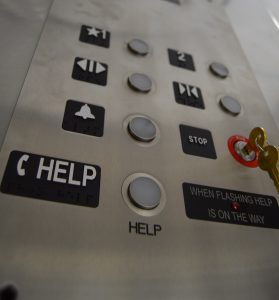Simple Elevator Phone Self-Test Highlights Communications Gap and Opportunity to Improve On-Site Safety and Tenant Experience

When you are entrapped in an elevator in California and need medical help, the last thing you want to hear from the person answering your emergency call is, “I’m in Connecticut and we don’t call 911.” Wait. What?
This isn’t the first time we’ve talked about things to consider when choosing an elevator monitoring company. Yes, you can choose who monitors your elevator phone and there are many reasons why using the elevator company call center or answering the calls in house isn’t your best option. The reality is, the scenario described happens more often than you realize and is exactly what happened when we met with a couple of California property managers recently.
Elevator Emergency Response Put to the Test
One of the managers was familiar with and had recommended Kings III but since the other one was not; they decided to survey their property to “push buttons” and see what happened when they tried to call for help. It was not a comforting experience.
Initially, they were appalled at how long it took to actually get someone to answer the call, (an average of three to five minutes, Kings III answers within seconds and code requires within 45 seconds) and from there, things went from bad to worse. Once they were connected they had to respond to a series of recorded prompts before being transferred to a live human. Unfortunately, once the operator answered she was not able to identify their location (also code required) and had no contact information for the building. When pressed as to what the operator would do if an entrapped passenger was having a heart attack and needed medical attention, they received the following response, “I’m in Connecticut and we don’t call 911.” Oh, and did I mention this was one of the major elevator company's call center answering? That was enough to reinforce the need for a change.
Paying More for Inadequate Response
After testing a few more elevators and receiving similar responses, they were now concerned what would happen if someone were actually entrapped. Next, we sat down to review just how much this disappointment was costing them and that proved enlightening as well. We discovered each month they were paying just under $5,000 for all 12 buildings (29 phone lines) under their management and determined that with our cellular technology, Kings III could save them nearly $3,000/month.
Important to note: using Kings III does not negate your current elevator contract as elevator phones are not usually covered. This exercise also highlighted that two-way communication alone is inadequate and just because you have a working phone in your elevator doesn’t mean you’ll get the help you need. In addition to the potential reduction in your monthly expenses, Kings III can also help:
Increase safety and reliability with calls being answered 24/7/365 in 175+ languages by our AEMD certified emergency dispatchers in our ETL Listed Central Station.
Mitigate risk & liability exposure as all calls are digitally recorded with a date and time stamp, and made available to customers upon request.
Manage tenant experience with dispatchers responding to callers with the utmost care, staying on the line until help arrives when requested and keeping you in the loop so that you have the opportunity to follow up after an incident.
Regrettably, we hear similar stories from new customers across California as well as nationwide. Learn more about how to improve tenant experience while eliminating your landlines and potentially saving money at www.kingsiii.com.
This guest blog post was provided by Jennifer Burks, New Market Launch Specialist, Kings III. Kings III is an ETL Listed Central Station, providing code compliant all-inclusive emergency help phone solutions for buildings, tenants, and visitors. Visit www.kingsiii.com to learn more about their services.


